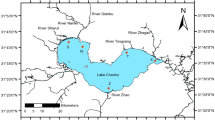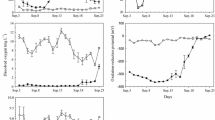Abstract
Endogenous phosphorus (P) release from sediments is an important factor to cause eutrophication and, hence, algal bloom in lakes in China. Algal decomposition depletes dissolved oxygen (DO) and causes anaerobic conditions and therefore increases P release from sediments. As sediment P release is dependent on the iron (Fe) cycle, electron acceptors (e.g., NO3 −, SO4 2−, and Mn4+) can be utilized to suppress the reduction of Fe3+ under anaerobic conditions and, as such, have the potential to impair the release of sediment P. Here, we used a laboratory experiment to test the effects of FeCl3, MnO2, and KNO3 on soluble reactive phosphorus (SRP) concentration and related chemical variables in the overlying water column during algal decomposition at different algal densities. Results showed that algal decomposition significantly depleted DO and thereby increased sediment Fe-bound P release. Compared with the control, addition of FeCl3 significantly decreased water SRP concentration through inhibiting sediment P release. Compared with FeCl3, addition of MnO2 has less potential to suppress sediment P release during algal decomposition. Algal decomposition has the potential for NO3 − removal from aquatic ecosystem through denitrification and by that alleviates the suppressing role of NO3 − on sediment P release. Our results indicated that FeCl3 and MnO2 could be efficient in reducing sediment P release during algal decomposition, with the strongest effect found for FeCl3; large amounts of NO3 − were removed from the aquatic ecosystem through denitrification during algal decomposition. Moreover, the amounts of NO3 − removal increased with increasing algal density.





Similar content being viewed by others
References
Andersen JM (1982) Effect of nitrate concentration in lake water on phosphate release from the sediment. Water Res 16(7):1119–1126
Boers P, Van der Does J, Quaak M, Van der Vlugt J, Walker P (1992) Fixation of phosphorus in lake sediments using iron (III) chloride: experiences, expectations. in: Restoration and Recovery of Shallow Eutrophic Lake Ecosystems. Springer, The Netherlands, pp 211–212
Chen X, Yang L, Xiao L, Miao A, Xi B (2012) Nitrogen removal by denitrification during cyanobacterial bloom in Lake Taihu. J Freshw Ecol 27(2):243–258
Christophoridis C, Fytianos K (2006) Conditions affecting the release of phosphorus from surface lake sediments. J Environ Qual 35(4):1181–1192
Chuai X, Ding W, Chen X, Wang X, Miao A, Xi B, He L, Yang L (2011) Phosphorus release from cyanobacterial blooms in Meiliang Bay of Lake Taihu, China. Ecol Eng 37(6):842–849
Foy RH (1986) Suppression of phosphorus release from lake sediments by the addition of nitrate. Water Res 20(11):1345–1351
Francis CA, Beman JM, Kuypers MMM (2007) New processes and players in the nitrogen cycle: the microbial ecology of anaerobic and archaeal ammonia oxidation. ISME J 1(1):19–27
Franco M, Mesel I, Demba Diallo M, Gucht VDK, Gansbeke VD, Van Rijswijk P, Costa M, Vincx M, Vanaverbeke J (2007) Effect of phytoplankton bloom deposition on benthic bacterial communities in two contrasting sediments in the southern North Sea. Aquat Microb Ecol 48:241–254
Gao L, Zhang L, Hou J, Wei Q, Fu F, Shao H (2013) Decomposition of macroalgal blooms influences phosphorus release from the sediments and implications for coastal restoration in Swan Lake, Shandong, China. Ecol Eng 60:19–28
Garcia-Robledo E, Corzo A, Garcia de Lomas J, Van Bergeijk S (2008) Biogeochemical effects of macroalgae decomposition on intertidal microbenthos: a microcosm experiment. Mar Ecol Prog Ser 356:139–151
Gillan DC, Pede A, Sabbe K, Gao Y, Leermakers M, Baeyens W, Louriño Cabana B, Billon G (2012) Effect of bacterial mineralization of phytoplankton-derived phytodetritus on the release of arsenic, cobalt and manganese from muddy sediments in the Southern North Sea. A microcosm study. Sci Total Environ 419:98–108
Gubelit YI, Berezina NA (2010) The causes and consequences of algal blooms: the Cladophora glomerata bloom and the Neva estuary (eastern Baltic Sea). Mar Pollut Bull 61(4):183–188
Hansen J, Reitzel K, Jensen HS, Andersen F (2003) Effects of aluminum, iron, oxygen and nitrate additions on phosphorus release from the sediment of a Danish softwater lake. Hydrobiologia 492(1-3):139–149
Hemond HF, Lin K (2010) Nitrate suppresses internal phosphorus loading in an eutrophic lake. Water Res 44(12):3645–3650
Hulth S, Aller RC, Gilbert F (1999) Coupled anoxic nitrification/manganese reduction in marine sediments. Geochim Cosmochim Acta 63(1):49–66
Jensen HS, Andersen FO (1992) Importance of temperature, nitrate, and pH for phosphate release from aerobic sediments of four shallow, eutrophic lakes. Limnol Oceanogr 37(3):577–589
Jiang X, Jin X, Yao Y, Li L, Wu F (2008) Effects of biological activity, light, temperature and oxygen on phosphorus release processes at the sediment and water interface of Taihu Lake, China. Water Res 42(8):2251–2259
Jin X, Tu Q (1990) Standard of Lake Eutrophication Survey of China. China Environmental Science Publishing House, Beijing (in Chinese)
Jin X, Wang S, Pang Y, Chang Wu F (2006) Phosphorus fractions and the effect of pH on the phosphorus release of the sediments from different trophic areas in Taihu Lake, China. Environ Pollut 139(2):288–295
Jones JG, Gardener S, Simon BM (1983) Bacterial reduction of ferric iron in a stratified eutrophic lake. J Gen Microbiol 129(1):131–139
Kim L-H, Choi E, Stenstrom MK (2003) Sediment characteristics, phosphorus types and phosphorus release rates between river and lake sediments. Chemosphere 50(1):53–61
Lamers LPM, Tomassen HBM, Roelofs JGM (1998) Sulfate induced eutrophication and phytotoxicity in freshwater wetlands. Environ Sci Technol 32(2):199–205
Pakhomova SV, Hall PO, Kononets MY, Rozanov AG, Tengberg A, Vershinin AV (2007) Fluxes of iron and manganese across the sediment–water interface under various redox conditions. Mar Chem 107(3):319–331
Petticrew EL, Arocena JM (2001) Evaluation of iron-phosphate as a source of internal lake phosphorus loadings. Sci Total Environ 266(1–3):87–93
Redshaw C, Mason C, Hayes C, Roberts R (1990) Factors influencing phosphate exchange across the sediment-water interface of eutrophic reservoirs. Hydrobiologia 192(2-3):233–245
Roden E, Edmonds J (1997) Phosphate mobilization in iron-rich anaerobic sediments: microbial Fe (III) oxide reduction versus iron-sulfide formation. Arch Hydrobiol 139(3):347–378
Ruban V, López-Sánchez JF, Pardo P, Rauret G, Muntau H, Quevauviller P (2001) Harmonized protocol and certified reference material for the determination of extractable contents of phosphorus in freshwater sediments – A synthesis of recent works. Fresenius J Anal Chem 370(2-3):224–228
Shang L, Ke F, Li W, Xu X, Song Y, Feng M (2013) Laboratory research on the contaminants release during the anaerobic decomposition of high-density cyanobacteria. J Lake Sci 25(1):47–54 (In Chinese)
Sirivedhin T, Gray KA (2006) Factors affecting denitrification rates in experimental wetlands: field and laboratory studies. Ecol Eng 26(2):167–181
Søndergaard M, Jensen JP, Jeppesen E (1999) Internal phosphorus loading in shallow Danish lakes. Springer, Shallow Lakes’ 98, pp 145–152
Søndergaard M, Jensen JP, Jeppesen E (2003) Role of sediment and internal loading of phosphorus in shallow lakes. Hydrobiologia 506(1):135–145
Sørensen J (1982) Reduction of ferric iron in anaerobic, marine sediment and interaction with reduction of nitrate and sulfate. Appl Environ Microbiol 43(2):319–324
van der Zee C, van Raaphorst W (2004) Manganese oxide reactivity in North Sea sediments. J Sea Res 52(2):73–85
Wauer G, Gonsiorczyk T, Kretschmer K, Casper P, Koschel R (2005) Sediment treatment with a nitrate-storing compound to reduce phosphorus release. Water Res 39:494–500
Wawrik B, Boling WB, Van Nostrand JD, Xie J, Zhou J, Bronk DA (2012) Assimilatory nitrate utilization by bacteria on the West Florida Shelf as determined by stable isotope probing and functional microarray analysis. FEMS Microbiol Ecol 79(2):400–411
Xie L, Xie P, Tang H (2003) Enhancement of dissolved phosphorus release from sediment to lake water by Microcystis blooms-an enclosure experiment in a hyper-eutrophic, subtropical Chinese lake. Environ Pollut 122(3):391–399
Zhu M, Zhu G, Zhao L, Yao X, Zhang Y, Gao G, Qin B (2013) Influence of algal bloom degradation on nutrient release at the sediment–water interface in Lake Taihu, China. Environ Sci Pollut Res Int 20(3):1803–1811
Acknowledgments
This work was supported by the National Natural Science Foundation for Youth (41403102) and the National Water Pollution Control and Management Technology Major Project (2012ZX07101-013).
Ethical statement
In this paper, I guarantee that the work described has not been published before, and it is not under consideration for publication anywhere else. I do not violate ethical standards, and there is no plagiarism in this study.
Author information
Authors and Affiliations
Corresponding authors
Additional information
Responsible editor: Philippe Garrigues
Rights and permissions
About this article
Cite this article
Wang, J., Jiang, X., Zheng, B. et al. Effects of electron acceptors on soluble reactive phosphorus in the overlying water during algal decomposition. Environ Sci Pollut Res 22, 19507–19517 (2015). https://doi.org/10.1007/s11356-015-5057-7
Received:
Accepted:
Published:
Issue Date:
DOI: https://doi.org/10.1007/s11356-015-5057-7




